Mostrar o rexistro simple do ítem
Análisis de la respuesta cardíaca de árbitros de fútbol en competición: estudio de caso
| dc.contributor.author | Castillo Alvira, Daniel | |
| dc.contributor.author | Cámara Tobalina, Jesús | |
| dc.contributor.author | Yanci Irigoyen, Javier | |
| dc.date.accessioned | 2016-11-30T12:48:45Z | |
| dc.date.available | 2016-11-30T12:48:45Z | |
| dc.date.issued | 2015 | |
| dc.identifier.citation | Sportis 2015, 1_2: 182-188 ISSN: 2386-8333 | |
| dc.identifier.issn | 2386-8333 | |
| dc.identifier.uri | http://hdl.handle.net/2183/17669 | |
| dc.description.abstract | ][Resumen] Los objetivos de este estudio fueron, por un lado, examinar la respuesta cardiaca de un árbitro de fútbol tanto durante un test de campo incremental como durante dos partidos en un torneo nacional de categoría cadete, y por otro lado, determinar las zonas de intensidad del árbitro durante los partidos atendiendo a su FCmax individual. Un árbitro de fútbol de categoría nacional fue equipado con un pulsómetro (Polar Electro Oy, Kempele, Finlandia) y su FC fue monitorizada durante la realización del Yo-Yo de recuperación intermitente nivel 1 (YYIR1) y durante dos partidos de un Torneo de Fútbol de categoría cadete. Las zonas de intensidad se establecieron atendiendo a la clasificación de Edwards (1993). La FCmax obtenida en el YYIR1 y en los partidos fue de 178 ppm y 161 ppm, respectivamente. Durante los partidos la FCmed registrada fue de 127 ± 1,03 ppm que corresponde a un 71,3% de la FCmax obtenida en el YYIR1. La distribución de la frecuencia cardiaca atendiendo a las zonas establecidas es la siguiente: 10 ± 1,95% (zona 1), 32 ± 1,65% (zona 2), 38 ± 5,14% (zona 3), 19 ± 4,31% (zona 4) y 1 ± 0,53% (zona 5). Los resultados obtenidos nos muestran que la FC más alta alcanzada en partidos de categoría cadete es inferior a la alcanzada en el YYIR1. Además, se observa que la carga interna, medida mediante FC obtenida en partidos, es inferior a la reportada en otros estudios con árbitros en partidos de categoría sénior | |
| dc.description.abstract | [Abstract] The aims of this study were: at first, to examine the cardiac response of an soccer referee both during an incremental field test and during two matches in a national Tournament Under 16 (U16), and secondly, to identify the different intensities of the soccer referee during the matches attending to his maximal heart rate (HRmax). A soccer referee of national competitive-level was equipped with a heart rate monitor (Polar Electro Oy, Kempele, Finland) and the HR was monitored during the Yo-Yo intermittent recovery level 1 (YYIR1) and during two matches of U16 National Tournament. The intensities were established attending to Edwards classification (1993). The average of HR (HRav) obtained in the YYIR1 and in the matches was 178 bpm and 161 bpm, respectively. HRav registered during matches was 127 ± 1.03 bpm approximately at 71.3% of FCmax obtained in the YYIR1. The percentage of time spent at different intensities during the matches was: 10 ± 1.95% (zone 1), 32 ± 1.65% (zone 2), 38 ± 5.14% (zone 3), 19 ± 4.31% (zone 4) y 1 ± 0.53% (zone 5). Our findings show that the highest HR reached during matches, is lower than HRmax registered during the YYIR1. Likewise, we can observe that internal match load, measured as a FC obtained during matches, is lower than the results of other studies during senior competitive-level matches. | |
| dc.language.iso | spa | |
| dc.publisher | Universidade da Coruña | |
| dc.relation.uri | http://dx.doi.org/10.17979/sportis.2015.1.2.1411 | |
| dc.subject | Carga interna | |
| dc.subject | Partidos | |
| dc.subject | Intensidad | |
| dc.subject | Cadete | |
| dc.subject | Internal load | |
| dc.subject | Match | |
| dc.subject | Intensity | |
| dc.subject | U16 | |
| dc.title | Análisis de la respuesta cardíaca de árbitros de fútbol en competición: estudio de caso | |
| dc.title.alternative | Analysis of cardiac response of soccer referees in competition: a case study | |
| dc.type | info:eu-repo/semantics/article | |
| dc.rights.access | info:eu-repo/semantics/openAccess | |
| UDC.journalTitle | Sportis | |
| UDC.volume | 1 | |
| UDC.issue | 2 | |
| UDC.startPage | 182 | |
| UDC.endPage | 188 |






